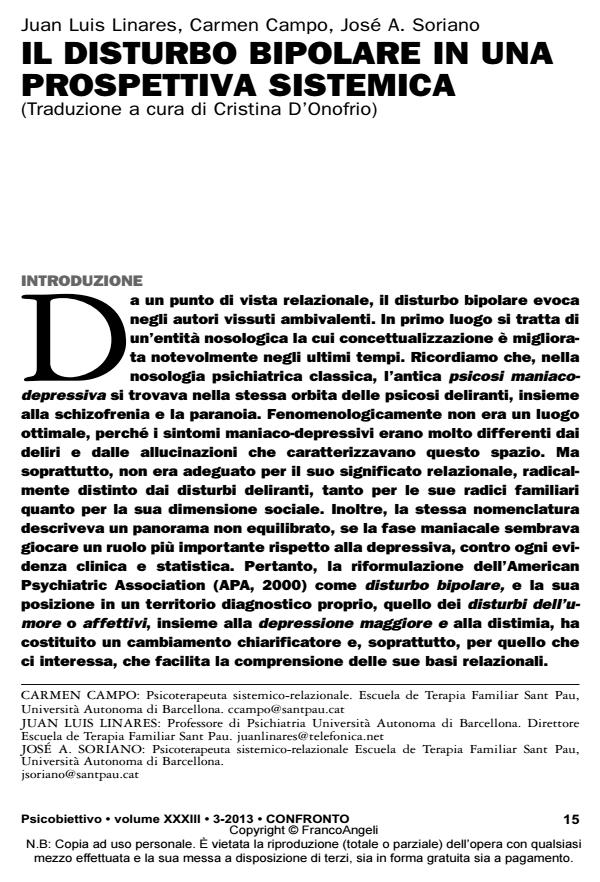Il disturbo bipolare in una prospettiva sistemica
Journal title PSICOBIETTIVO
Author/s Juan Luis Linares, Carmen Campo, José A. Soriano
Publishing Year 2014 Issue 2013/3 Language Italian
Pages 20 P. 15-34 File size 182 KB
DOI 10.3280/PSOB2013-003002
DOI is like a bar code for intellectual property: to have more infomation
click here
Below, you can see the article first page
If you want to buy this article in PDF format, you can do it, following the instructions to buy download credits

FrancoAngeli is member of Publishers International Linking Association, Inc (PILA), a not-for-profit association which run the CrossRef service enabling links to and from online scholarly content.
Bipolar disorder is a relatively new nosological entity that has emerged out of what was previously known as manic-depressive psychosis. However, whereas the latter was classified along with the delusional psychoses, bipolar disorder is now more appropriately located among the mood disorders. Its relational bases reveal a combination of organizational characteristics that are indicative of emotional deprivation and chaotic relationships in the family of origin, whereas the couple relationship is likely to be marked by confusion, since where the patient is along the bipolar continuum will determine whether the relationship with the partner is one of complementarity or symmetry. In terms of mythology, patterns of disconfirmation in the family of origin may combine with other examples of disqualification and rejection which, while occurring initially in the family of origin, subsequently spread to the couple relationship and the created family. As for the parents of the bipolar patient, one tends to be orderly (the "ant") while the other is a transgressor (the "grasshopper").
Keywords: Key Words: Bipolar Disorders; Relational Psychopathology; Systemic Psychotherapy; Disconfirmation; Disqualification; Family Organization; Family Miths.
- APA (American Psychiatric Association) (2000) Diagnostic and Statistic Manual of Mental Disorders: DSM IV-TR, Washington DC
- Baillarger J. (1854) “De la folie à double forme”, Annales médico-psychologiques, 6: 369-389
- Becoña E., Lorenzo M.C. (2001) “Tratamientos psicológicos eficaces para el trastorno bipolar”, Psicothema, 13, 3: 511-522
- Cancrini L. (2002) “La depressione in psicoterapia”, Ecologia della Mente, 25, 2: 127-138 Cancrini L., La Rosa C. (1991) Il vaso di Pandora, Nuova Italia Scientifica, Roma
- Cancrini L., De Gregorio F. (1997a) “L’area delle psicosi e il grupo delle schizofrenie: il contributo della psicoterapia ad una moderna nosografía dei disturbi psichiatrici maggiori”, Ecologia della mente, I, 20: 23-34
- Cancrini L., De Gregorio F., Nocerino S. (1997b) “Las familias multiproblemáticas”, in Coletti M., Linares J.L. (a cura di), La intervención sistémica en los servicios sociales ante la familia multiproblemática. La experiencia de Ciutat Vella, Paidós, Barcelona
- Casagrande G., Mosconi A. (2006) “Modalità relazionali e sistema di significato nella depressione”, Terapia Familiare, 81: 35-65
- Falret J.P. (1854) “Mémoire sur la folie circulaire, forme de maladie mentale caractérisée par la reproduction successive et régulière de l’état maniaque, de l’état mélancolique, et d’un état lucide plus ou moins prolongé”, Bulletin Académie nationale de médecine, 19: 382-400
- Goldbeter A. (2013) “Origin of Cyclicity in Bipolar Disorders: A Computational Approach”, Pharmacopsychiatry, 46 (suppl. 1): 44-52
- Hooley J.M., Woodberry K.A., Ferriter C. (2005) “Family factors in schizophrenia and bipolar disorder”, in Hudson J.L., Rapee R.M. (eds.), Psychopathology and the Family, Elsevier, Amsterdam
- Justo L.P., Soares B.G.O., Calil H.M. (2008) “Intervenciones familiares para el trastorno bipolar” (Revisión Cochrane traducida), La Biblioteca Cochrane Plus, 2, Oxford
- Kahlbaum K.L. (1863) Die Gruppirung der psychischen Krankheiten, Verlag von A. W. Kafemann, Danzig
- Kraepelin E. (2000-2003) Lehrbuchder Psychiatrie (ultima edizione in quattro volumi), Belleville Verlag, Munich
- Kretschmer E. (1941) Medizinische Psychologie, Thieme v., Leipzig
- Linares J.L. (2002) Del abuso y otros desmanes. El maltrato familiar, entre la terapia y el control, Paidós, Barcelona (trad. it. Armando, Roma, 2007)
- Linares J.L. (2012) Terapia familiar ultramoderna. La inteligencia terapéutica, Herder, Barcelona
- Linares J.L., Campo C. (2000) Tras la honorable fachada. Los trastornos depresivos desde una perspectiva relacional, Paidós, Barcelona (trad. it. FrancoAngeli, Milano, 2000)
- Miermont J. et al. (1987) Dictionnaire des Thèrapies Familiales. Théories et Pratiques, Payot, Paris
- Miklowitz D.J. (2010a) Bipolar Disorder. A Family-Focused Treatment Approach, Guilford Press, New York
- Miklowitz D.J. (2010b) “Tratamiento coadyuvante para el Trastorno Bipolar: Actualización de las evidencias”, Revista de Toxicomanías, 59: 3-17
- Miklowitz D.J. (2011) The Bipolar Disorder. Survival Guide, Guilford Press, New York
- Mosconi A. (2008) “Terapia relazionale-sistemica con l’individuo. Il “quadrilatero sistemico” come riferimento per una costruzione di ipotesi ben formata e l’integrazione di diferenti ottiche di lavoro, ovvero, ‘Fai una buona ipotesi e poi fai quello che vuoi’”, Connessioni, 20: 55-82 Mosconi A., Trotta B. (2011) “Depressione e psicosi bipolare: non sono le cose che ci preoccupano ma l’idea che abbiamo di esse”, in Chianura P. et al. (a cura di), Manuale clinico di terapia familiare. Volume I: Processi relazionali e psicopatologia, FrancoAngeli, Milano
- Reinares M., Vieta E. (2008) “Intervención familiar psicoeducativa en el trastorno bipolar. Infocoponline”, Revista de Psicología, 1: 1-4
- Schneider K. (1943) Las Personalidades Psicopáticas, Ed. Morata, Madrid
- Stierlin H., Weber G., Schmidt G., Simon F.B. (1986) “Features of Families with Major Affective Disorders”, Family Process, 25, 3: 325-336
Juan Luis Linares, Carmen Campo, José A. Soriano, Il disturbo bipolare in una prospettiva sistemica in "PSICOBIETTIVO" 3/2013, pp 15-34, DOI: 10.3280/PSOB2013-003002